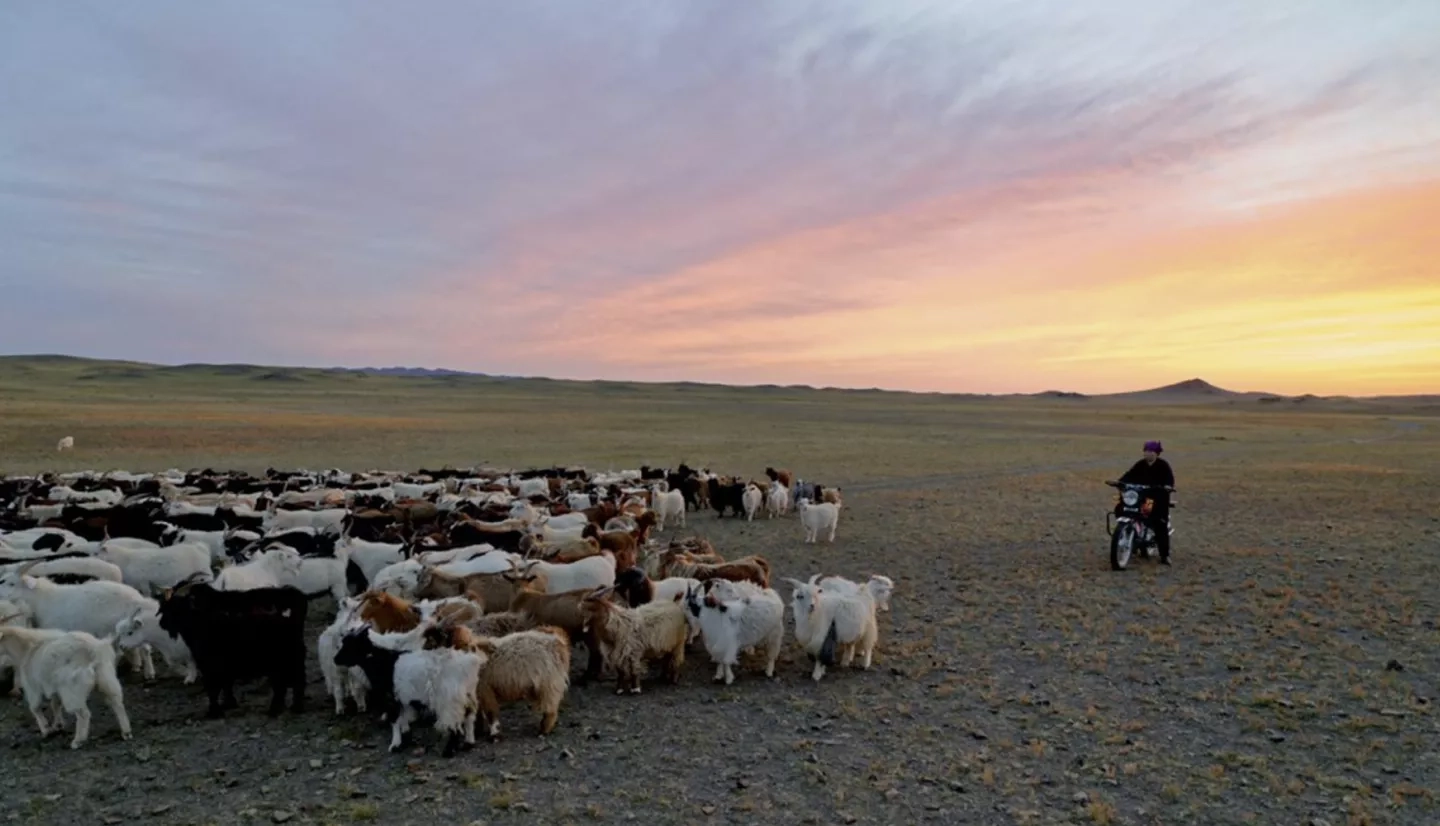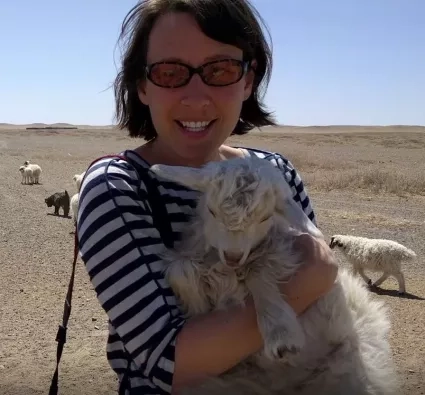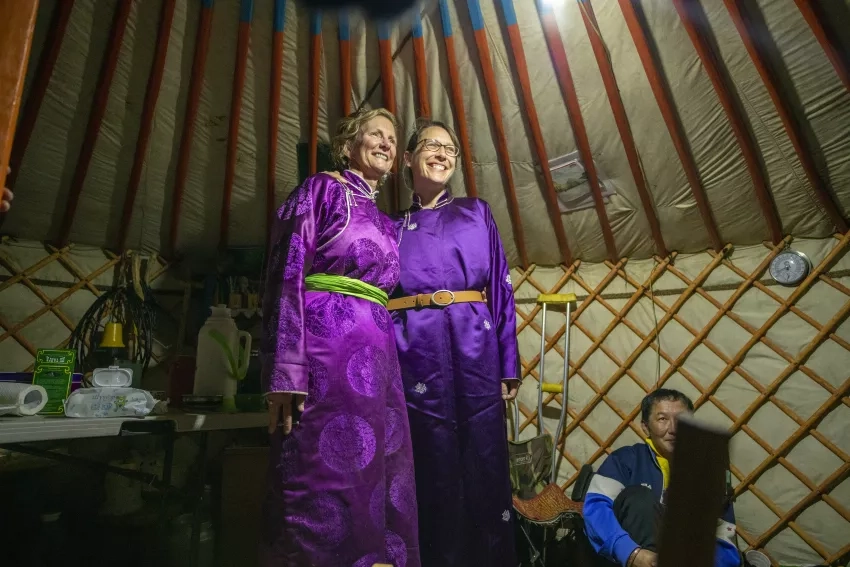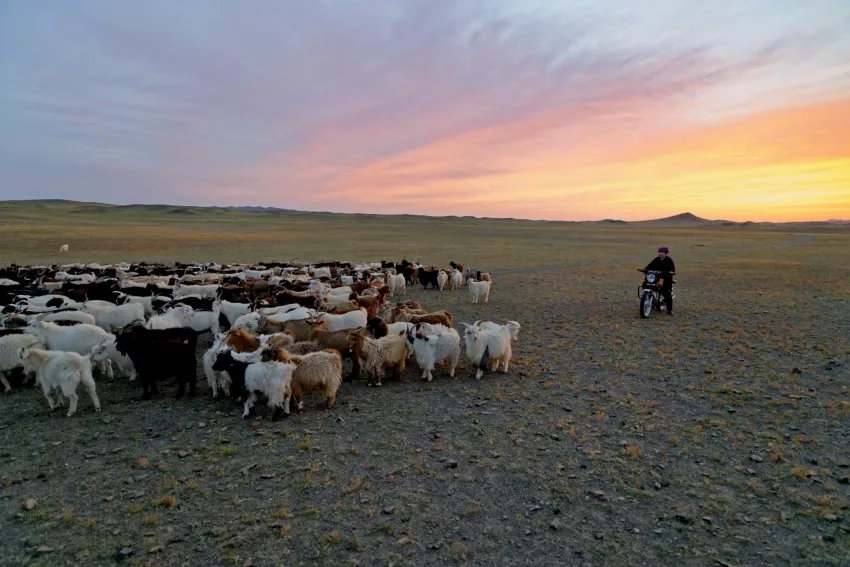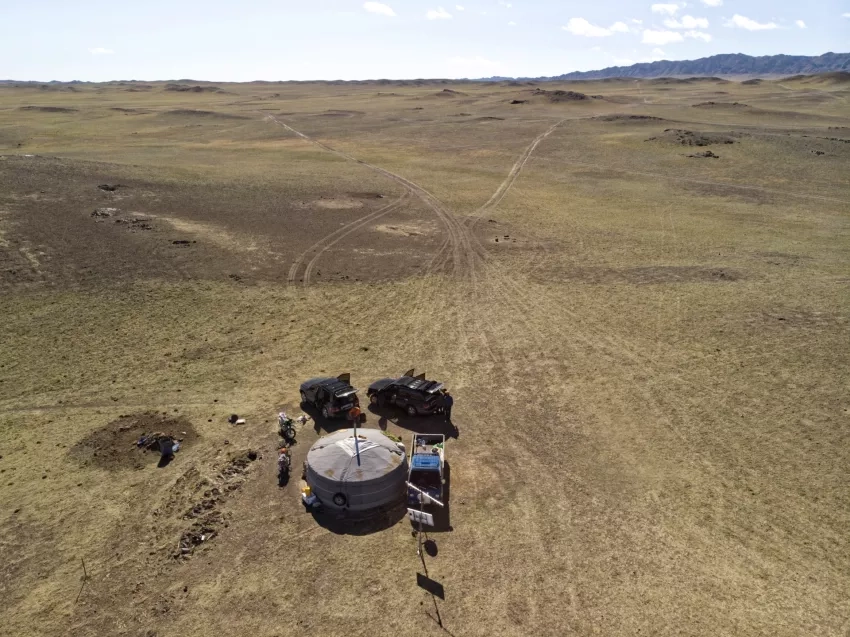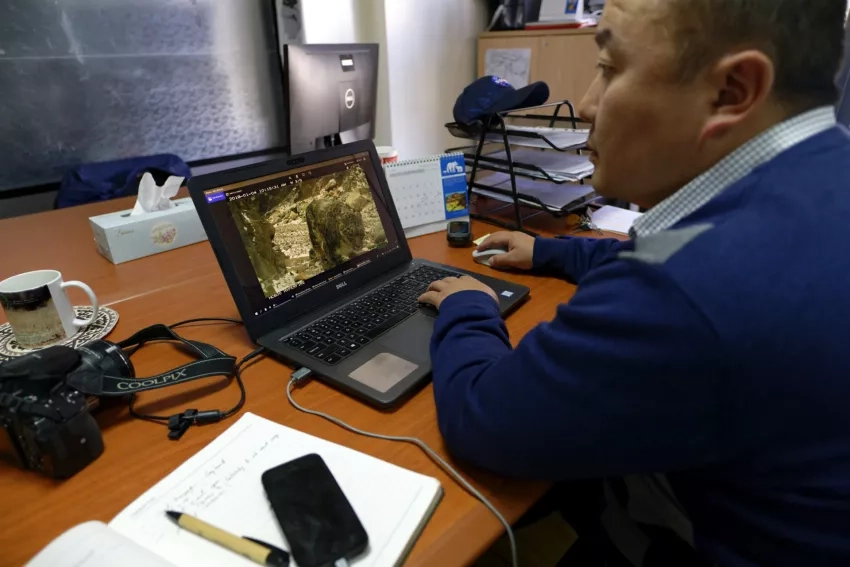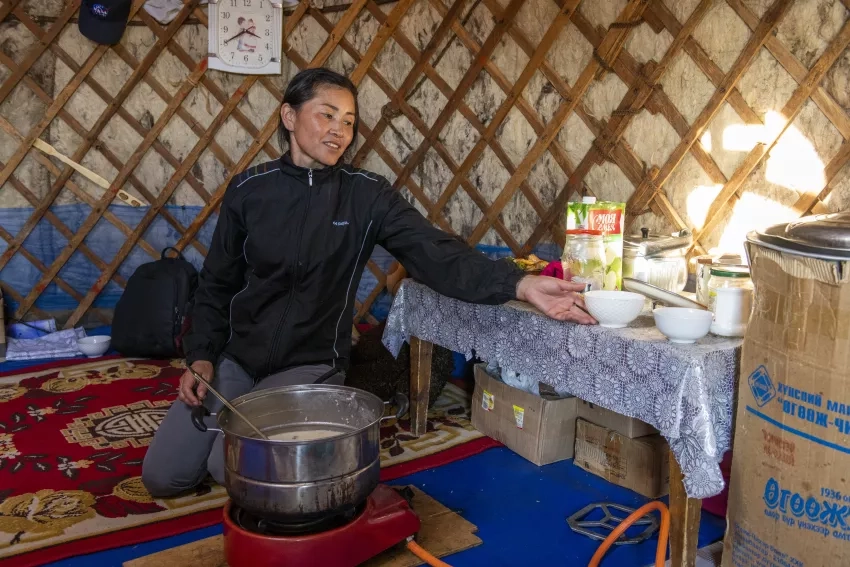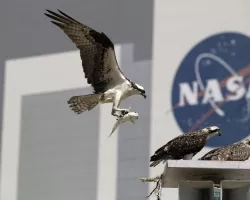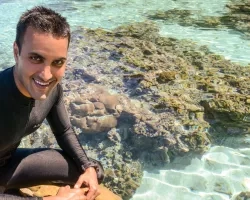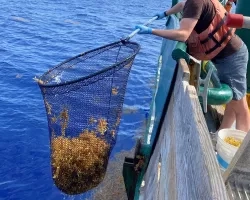The Gobi Desert is a vast and arid place, stretching over 500,000 square miles across Mongolia and China. It’s also a source of life and livelihood for Mongolian goat herders and their animals. But climate change and overgrazing are putting the Gobi’s ecosystem in danger, threatening their capacity to support all the animals and humans who rely on it.
Becky Chaplin-Kramer, the lead scientist with Stanford University’s Natural Capital Project (NatCap), is supplying critical science to help address degradation in the Gobi through a unique partnership called the Sustainable Cashmere Project. This unusual alliance includes a mining company, Oyu Tolgoi, a global sustainable luxury fashion conglomerate, Kering (who own brands like Gucci and Balenciaga), and an environmental NGO, the Wildlife Conservation Society. They all aim to improve rangeland conditions in the Gobi while also improving herders’ livelihoods through regenerative grazing. Funded in part by NASA, the team is using satellite data and dynamic modeling to measure the health of the rangeland and livestock and assess the project’s impact.
When Chaplin-Kramer first arrived in the Gobi for field work, the first things that struck her were the region’s vastness and diversity. She was amazed at how many ways a desert could look. Even just looking across the landscape, she could see different kinds of plants growing and different weather patterns compared to where she stood.
“On one of the trips we drove the whole 12 hours from Ulaanbaatar to the Gobi,” Chaplin-Kramer said. “You really get a sense of the challenge of what we’re trying to do here, and why I think the improvements in satellite resolution and spectral capacity will really change things here. It’s just so variable spatially as you’re driving along, it’s so patchy. It can have a sudden transition to something else. It’s unlike anything I've ever seen.”
A lifelong camper and nature enthusiast, Chaplin-Kramer is used to that sense of wonder when observing nature. Born to two conservationist parents, she fell in love with the great outdoors as a teenager — how it made her feel so small, and yet so connected to everything. She followed in her parents’ footsteps in college, setting out to find ways to save nature.
She quickly realized, however, that “nature” will always exist in some form; it’s people and our current ways of life that are most threatened by global change. “If we want to maintain a livable condition on this planet then we need to find ways to coexist and thrive with nature," she explained. It was in joining NatCap that she found a promising way to help achieve this.
Chaplin-Kramer and her colleagues at NatCap investigate the changes nature undergoes and how nature benefits people. They strive to quantify the value of the services nature provides, like marshes cleaning our water and protecting us from floods or pollinators boosting our crop production.
“People are so disconnected from nature, so they don’t understand the power and the benefit of nature and ecosystems on their own lives,” said Cindy Schmidt, an associate program manager with NASA Applied Sciences Ecological Forecasting program area. Schmidt oversaw Chaplin-Kramer's work with the Sustainable Cashmere Project. “We have to make those connections. Becky and her group are really leading the way in that area.”
The Sustainable Cashmere Project itself was the first time NatCap used near real-time satellite data in their work, and this decision made a big difference in the project’s outcome. We connected with Chaplin-Kramer to talk more about her role in the project and its impact on managing rangeland ecosystems in the Gobi and beyond.
How did you get involved with this project?
When we first started talking to the fashion company Kering, one of the co-founders of the Sustainable Cashmere Project, it was about improving the way biodiversity and ecosystem services are accounted for in their environmental profit and loss methodology. The problem was that it was all loss, and no profit. Because the way they measured it was always in relation to a pristine baseline — how their footprint impacts the way nature would be if it was wild.
They wanted to change that with the Sustainable Cashmere Project: to provide a case study on how you move beyond reducing your negative impact and actually do regenerative business. How to go into places that are degraded and make them better instead of just avoiding them, which is a zero-sum game. Because if good actors stay out of sensitive places, then it will just be bad actors going there.
We’re trying to develop these methodologies so Kering can count those regenerative actions toward a profit of environment benefit instead of just loss. The difficult thing about fiber supply chains is that they’re so long, there are so many steps. You can get bad actors anywhere along it. It was a real challenge for Kering to change production practices when they’re at the very end of this supply chain. Their major innovation was to shorten the chain by going directly to herders, so that they could help inspire change instead of getting lost with all the middlemen in between.
What has been the most surprising aspect of your work on this project?
I would be remiss if I didn’t include some of the interesting fun facts I’ve learned, like that you get the best cashmere from the most stressful environments. When it’s really dry, hair gets thinner and finer. You want the thinnest, finest fiber to go into your highest quality cashmere, so raising goats in these extremely arid and precarious environments gives you the highest quality product. It also means it’s the highest risk. Clearly no one wants their animals to suffer, or for the herd to be at risk with climate variability. So, it’s a narrow, tight rope that these herders have to walk.
The most surprising piece of the science I learned was that climate change might actually benefit Mongolia, but it will also raise the stakes and make production riskier. We found through our modeling that future climates will likely make the Gobi Desert more productive because it will get wetter and warmer. The problem is that, based on what we’ve seen in the past, that can worsen or exacerbate overstocking problems so that when extreme events do happen, the outcomes will be even more devastating.
What challenges or setbacks have you faced on this project?
Everything you think you know about how grazing is supposed to work is upside down. This is a disequilibrium system, meaning one that's decoupled from the plant-herbivore interaction, so herbivores don’t always have the impacts you expect them to. In this case, we saw that climate was a stronger driver of rangeland condition than grazing.
It was the plan of the whole project to change grazing practices to change the quality of the rangelands. But the rangelands are so driven by climate that there’s only so much of a difference you can make. What you can do a lot better is protect herders and their livelihoods by trying to adapt herd sizes to fit better within the bounds of the system.
We had to change tactics there — the whole project, not just the science. We changed the intended output of the monitoring and modeling to focus a little bit more on welfare and animal conditions, not just the rangeland conditions, which is certainly impacted but also not totally in the herders’ control.
What’s something you’re proud of with this project?
I think what we did best was adapt. What we understood going into the project was not what we understood halfway through the project or by the end of the project. Our expectations around what management would be able to change shifted, as well as what we were trying to help support our collaborators with.
For example, Oyu Tolgoi needed to meet lender requirements to offset their impacts by establishing a 15 percent improvement in rangeland conditions. With climate variability being what it was, that’s not necessarily a reasonable expectation for the herders to achieve, especially in a short amount of time just through changing management practices. We saw huge swings from a wet to dry year in 2018 and 2019, from flash floods to major droughts. That obviously impacts the condition of the rangeland, and it’s hard to tease apart the management impacts just through straight ground monitoring.
That’s where modeling comes in. We built a coupled rangeland-livestock model in order to explore changes in future climate and which places around the region we could expect to have the largest impact from changing grazing management, and by pairing this modeling with the remote-sensing we’re able to tease apart the effects we think are due to climate vs. management.
We also pivoted to address the challenge of matching satellite observations with on-the-ground monitoring. It turned out to be really hard to match their on-the-ground monitoring with the precision needed to be able to detect a 15 percent change — if there even was one. But we were able to use the remote sensing as a way of screening places that should be prioritized for field monitoring, so that their resources can be deployed most efficiently. It said a lot about the trust and commitment that we built with this group — that we could change the goalposts and adapt to our changing understanding of the situation and still come out with a successful product.
Why is this work important? What impact can it have not just for the Sustainable Cashmere Project but for elsewhere as well?
I think what we’ve done here is not just to answer a couple of questions in this particular context. We developed a whole approach we could replicate for other applications. Ultimately, we see this as a path to scaling up regenerative grazing in general based on the modeling and monitoring that we co-developed.
Stuart Anstee, one of the co-founders of the project, spun off a new company called Good Growth. Its business model has evolved from this project already. It puts regeneration instead of profits at its center. The ability to succeed as a business is dependent on regenerative production. And even better, they want to use the best available science to help define what regeneration means – which can be hard to see qualitatively, especially in places like the Gobi.
Good Growth is starting to move outside the Gobi, too. They have pilots around Mongolia as well as in Patagonia, and they’re interested in expanding to all the dominant rangeland areas of the world. Importantly, they’re committed to monitoring their impact as part of their core business, so they’re looking for more cost-effective ways to sustain that than currently resource-intensive field monitoring. Their question has become, how can we use remote sensing to expand or complement monitoring on the ground?
One of the ideas we have is looking at long-term historical trajectories because that’s something that can’t be done with field monitoring—we can’t go back in time to measure a place they start working to see how it’s changed. But with remote sensing going back decades, we can understand the trajectory they’ve been on and how additional changes deviate from that trajectory. I think this new opportunity with Good Growth and a variety of other opportunities through NGOs and NGO-business partnerships can really support the next generation of sustainable rangeland production.
Do you have any favorite stories or lessons learned from your field work in Mongolia?
They’re such warm people. I don’t think I’ve ever worked in a place where I’ve felt so welcome despite being such a clear stranger. It’s just an amazing place. The Gobi is starkly beautiful, yet also vibrant and full of life and sharing and community. When we would visit people in their gers (the Mongolian word for yurt), people would come out from neighboring properties and all gather around in the middle of someone’s ger.
One of the things they can do is sing, it’s just the best. And their songs involve these long, epic stories, which they can literally sing for hours, and everyone knows all the words to all the songs.
The feeling of harmony that comes across from that is so clear and I feel like it extends to the harmony that we’re seeking for people and nature. The herders we’re working with have been such amazing stewards for this land despite challenging conditions and sort of perverse incentives. Mongolia has a program where there’s an award given to the person with the most livestock. Herders have told me “That is not good, we should not be rewarding people for having too many animals because they can’t take care of them if they have too many animals.” So many of these herders are just so committed to their craft and trying to live the sustainable ways that they have for generations. It’s one of the coolest things I’ve ever seen.
To learn more about this work, read about it in the Applied Sciences story, Making Cashmere More Sustainable, From Desert to Runway. and the NASA.gov story, NASA "Steppes” onto the Runway to Make Mongolian Cashmere Sustainable.
